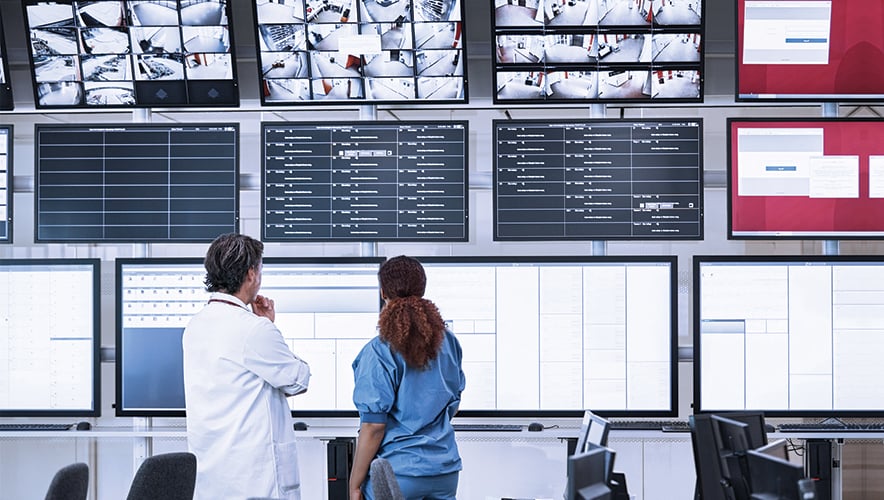Unifying Communications for a Stronger Security Posture in the Healthcare Setting
 For modern healthcare facilities, balancing safety and security with a welcoming environment requires a comprehensive approach. In short, maintaining this balance necessitates significant coordination across a wide variety of functions. While that seems simple, the process is nothing but complex.
For modern healthcare facilities, balancing safety and security with a welcoming environment requires a comprehensive approach. In short, maintaining this balance necessitates significant coordination across a wide variety of functions. While that seems simple, the process is nothing but complex.
Organizations must provide a high level of safety and protection for visitors, patients, staff, and assets. Well-outlined processes and standard operating procedures create a solid baseline, but technology also plays a pivotal role in helping keep a hospital safe and operational.
The use of modern solutions, such as access control, communications infrastructure, and intrusion detection, provides peace of mind as security leaders and caregivers collect and interpret a large quantity of data to gain insight into the facility’s inner workings and keeps individuals safe from outside threats.
Challenges Abound
Healthcare facilities are typically safe havens for the sick. Constant care from attentive caregivers makes patients feel comfortable and secure. But behind the scenes, the healthcare industry is an at-risk environment. Various challenges and risks grow daily, all of which make comprehensive security a challenge.
A bad actor, an angry former employee, or a desperate family member can all pose a threat. When an emergency occurs, responding in a timely and efficient manner is crucial. Stakeholders can achieve rapid response through a common, unified communications infrastructure that drives immediate and effective dispatching to resolve incidents quickly and safely.
A bad actor, an angry former employee, or a desperate family member can all pose a threat.
Enhancing situational awareness to support faster response is vital. Traditional communications methods often rely on manual calls and radio updates, and because of this approach, visibility can be limited when providers and patients need it the most. A communications strategy incorporating modernized offerings, like cloud-based intercom solutions and intelligent telesitter offerings, can help security teams oversee a situation and engage with and direct the full spectrum of a hospital's response with actionable insights.
In one specific instance, a large healthcare system’s internal communication systems were highly valuable tools because they ensured high-quality and immediate communication and the rapid exchange of information. But the healthcare organization faced a common problem: its existing security and communication devices were no longer well-suited to meet the challenges of modern-day healthcare facilities.
“Enabling alarm management and communication controls into a centralized solution would enable us to access more data and integrate more devices,” a representative of the healthcare organization said. “We envisioned a one-stop solution designed to make us more effective as a team.”
Ongoing Challenges
As we can all attest, COVID-19 brought a more significant focus on communication and the coordination of security and safety. Managing access to healthcare facilities, especially during the height of the pandemic, propelled a much larger focus on protecting high-risk patients, such as someone with cancer who is immunocompromised, from those individuals exposed to the virus. For example, it became commonplace for new patients to answer pre-entry screening questions. This was added as a safety measure at the initial point of contact for incoming patients and helped separate the at-risk from any COVID-positive or suspected cases.
With so much at stake when providing healthcare during COVID-19, technology investments were needed to realize a multi-layered approach to protection and communication between departments and providers. Video surveillance and access control were often the first investment choices. Still, many providers often found that they had to focus on the basics first: building a comprehensive communications infrastructure to ensure rapid response and informed decision-making.
Technology is crucial in helping hospitals and clinics gain flexibility; life-saving decisions often must be made at a moment's notice. Ensuring reliable contact is where intercoms come into play. These solutions can provide clear verbal transmissions to clarify difficult ambient conditions. With scalable and efficient workflows, intercoms can enhance the visitor, patient, and staff experience. Reliable and secure intercom platforms reduce the need for unnecessary guard intervention while clinical efficiency is elevated with two-way communication.
Rapid response and effective communication can significantly affect patient health in these complex and fast-moving environments, especially in emergency and operating rooms. On top of the core capabilities, intercoms provide a unified, integrated communication platform that combines security, video, access, and audio capabilities and can give direct multi-site contact across facilities, laboratories, patient rooms, and quarantine areas. It also supports necessary functions for efficient door access for high-risk areas, such as maternity wards, pharmacies, nurseries, and limited access areas.
For regular operations, acoustic room surveillance makes it easy to keep many rooms and patients under observation. Operators can customize alerts based on individual patient needs. For example, a hospital can monitor each facility through a centralized security operations center and empower rapid response. When a nurse call button is pushed, it feeds into the centralized security operations center, and a reply is dispatched.
“If an alarm comes in, operators can interact with guards on-site to see what is happening,” a large healthcare organization said. “Our newer alarms are supported with video, which provides additional evidentiary support and is highly valuable.”
Two-way, real-time audio can integrate with remote sitter workstations to enable centralized patient monitoring. With speakers and microphones ceiling-mounted in each patient room and connected to a remote sitter platform, healthcare facilities can quickly give audible notifications and instructions to the patient. But it is critical that audio quality and microphone dynamics provide the clarity required to overcome the acoustically challenging environment within a hospital. Even with this functionality, hospitals have the power to accurately detect privacy violations and comply with an organization’s top privacy priorities.
We’re only beginning to see use cases evolve for intercom systems. The end users—the security leaders and the medical practitioners—are finding new ways to leverage technology to support changing needs. But one thing is for certain: a unified approach to communications reduces maintenance and integration costs while providing a robust platform to build a powerful communications strategy. It’s the baseline that paves the way to greater efficiencies and a safer environment.
Anthony Babicz is director of sales, Commend Americas, where he leads the company's sales and go-to-market initiatives for unified communications and security functions. He came to Commend from IdentiSys, where he led District Sales for access control, video surveillance, and identification technology.
